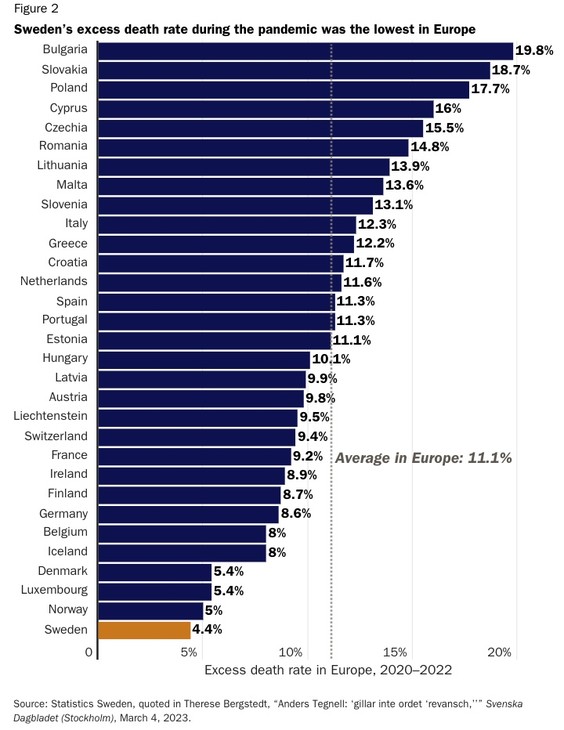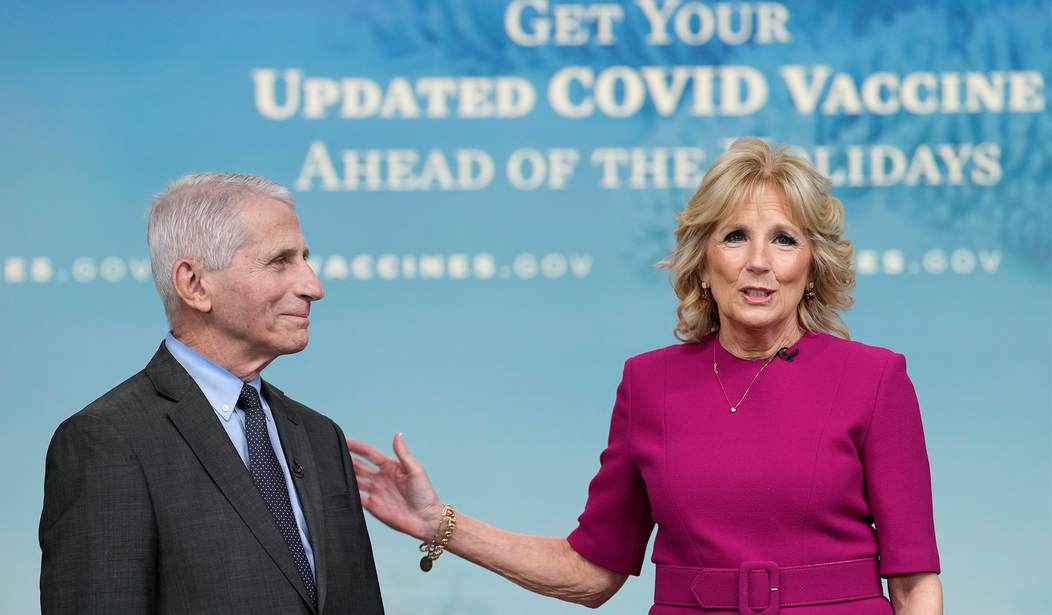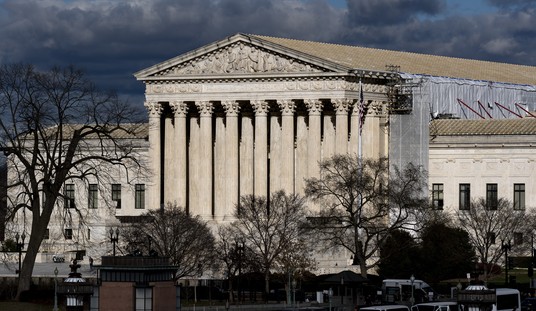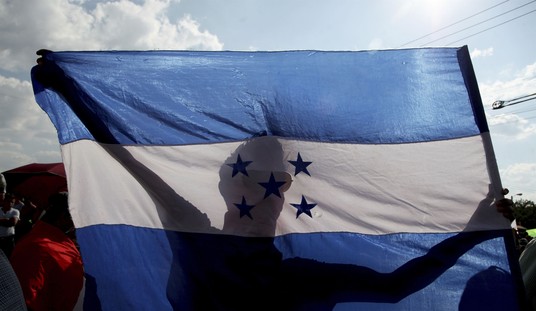If you guess the country that locked down the tightest, collect your consolation prize from our hazmat-suited assistant at the door. If you guessed the country that imposed the harshest mask and vaccine mandates, you don’t even get a kewpie doll.
If, however, you guessed the country that mainstream media pilloried and turned into a “cautionary tale,” you win the big prize. A new study published by Cato cuts through all of the manipulated correlative data and focuses on the bottom line: excess deaths during the three years of the pandemic. Guess which country had the lowest excess death rate increase? And more importantly, guess why:
During the COVID-19 pandemic, Sweden stood out from other countries, stubbornly refusing lockdowns, school closures, and mask mandates. This was highly controversial and many outsiders saw it as a dangerous gamble with human lives. From a Swedish perspective, however, it looked like it was other countries that were engaging in a dangerous experiment.
This paper describes Sweden’s policies and the reasons for its choices, and it presents some preliminary conclusions about the results. Sweden’s economy got through the pandemic better than comparable countries, and elementary school students have not suffered learning losses. These benefits do not seem to have come at the expense of human health. Remarkably, total excess deaths were smaller in Sweden than in any other European country during the three pandemic years (2020–2022), and the rate was less than half of America’s. In the absence of strict government control, Swedes adapted their behavior voluntarily.
Using data reported by the countries themselves, the study compares excess death rates during the pandemic. This allowed the researchers to negate the various and somewhat contradictory ways in which different countries counted COVID-19 deaths. Sweden, for instance, adopted the US’ correlative approach by chalking up any death with a correlating COVID diagnosis as a COVID death (which the US still uses for both deaths and hospitalizations). Norway, on the other hand, required a doctor to certify COVID as the actual cause of the death for counting, which makes the two incompatible for comparison.
The only way to accurately and equally compare outcomes of pandemic policies is through the excess-death metric. And the results are not even close:

The open-source Our World in Data site makes the difference even more dramatic. Its pandemic excess-death findings puts the US increase at 13%, worse than the EU average found in this study, while reporting Sweden’s at 5%. (Russia’s excess-death rate was 21%. China, notably, has never reported this data.) The study points out that although the Nordic countries group at the bottom (or top, depending on perspective), Sweden’s results are surprising given their differences:
Despite differences in methods and results, all these studies suggest that in terms of COVID-19 fatalities, Sweden is a typical Nordic country. That is startling, since in comparison with its neighbors, Sweden has higher population density, more overcrowded households, and a higher share of foreign‐born people (a group that turned out to be particularly vulnerable). Preben Aavitsland at Norway’s public health agency concludes that “other countries managed to delay some deaths, but now, three years after, we end up at around the same place.”34 Just as Sweden’s epidemiologists had predicted.
Excess deaths are only one measure of success. An even clearer conclusion can be made from economic and education data:
The Swedish economy is very open and export dependent, so when the world suffers, so does Sweden. However, Sweden’s economy did much better than comparable countries. The world economy was 2.9 percent smaller after 2021 than it would have been according to the Organisation for Economic Co‐operation and Development forecast before the pandemic; the Eurozone 2.1 was percent smaller, and the U.S. economy 1.2 percent smaller. The Swedish economy was 0.4 percent bigger.36 This is even more exceptional since the Swedish government introduced much less fiscal stimulus than most other countries.
So, not only does freedom perform better but it also costs less. Who could have guessed that? Freedom also allows children to keep up with their education and socialization, which had both short- and long-term benefits for Sweden in comparison to other Western nations. At this point, author Johan Norberg draws an explicit comparison to results in the US:
The U.S. Department of Education concluded that half of America’s students began 2023 a full year behind grade level in at least one subject. “We’re seeing that they’re starting the school year off about the same as they were last year,” says Rachel Hansen at the National Center for Education Statistics.38
In sharp contrast, Swedish elementary schoolers suffered no learning loss during the pandemic, according to a study in the International Journal of Educational Research that examined word decoding and reading comprehension. The scores were not lower during the pandemic and children from low socioeconomic backgrounds were not especially affected.39
In lockdown countries, other health interventions suffered when all action was focused on COVID-19. In 2021 alone, 25 million children missed out on childhood vaccinations globally, the biggest drop in 30 years.40 In some American states there was a drop in coverage with measles, mumps, and rubella vaccines of around 5 percentage points during the pandemic.41 By contrast, Sweden did not suffer a drop at all. In 2020 the Swedish childhood vaccination rate was 97.2—up by a tenth of a percentage point from the year before.42
But why did Sweden outperform countries that mandated lockdowns, masking, and later vaccinations? Norberg credits freedom combined with common sense for depoliticizing pandemic mitigation. People adjusted to the data as it came, had a better sense of risk management, where autocratic policies elsewhere created backlash and anger:
One reason why Sweden got through the pandemic in a much better shape than many scholars, journalists, and politicians expected was that they only thought in terms of strict government controls or business as usual. They failed to consider a third option: that people adapt voluntarily when they realize that lives are at stake. Swedes quickly changed their behavior and mostly followed the recommendations. As early as April 2020, half the workforce worked from home and public transport usage had declined by half. Mobility data from telecom providers show that mobility patterns in Sweden were similar to those in neighboring countries. If anything, Swedes reduced their travel a bit more in the aggregate.35
The difference was that if Swedes decided, based on local knowledge and individual needs, that they had to go to work, exercise, or meet a relative or a friend, they could do that without being stopped by the police. This meant that the pandemic became less politicized in Sweden and perhaps also that people accepted the need to live under extraordinary conditions for longer than they would have if they didn’t have these individual emergency exits.
Now … imagine a US in 2023 where freedom and liberty had been the core values for dealing with the pandemic. Our children would not be a year or more behind in education and perhaps even further back on socialization. We would not have needed to spend more than $8 trillion on emergency support for a government-torpedoed economy. After getting good data on the actual risks of the COVID-19 virus, we might have targeted mitigation efforts at the limited high-risk demographic. We might not have bought into succeeding waves of mutation hysteria, but comprehended that viral strains almost always tend to mutate into less dangerous strains over time. And we certainly wouldn’t have tolerated government censorship of dissent and debate over pandemic policies.
Instead, we can blame two administrations and their reliance on supposed “experts” for imposing a technocracy rather than sticking to liberty. And as Christian Britschgi reminds us at Reason, we can blame the mainstream media that fueled the panic that led to those policies — the media that got Sweden wrong too:
The concurrent spike in COVID deaths it experienced, particularly in comparison to its Scandinavian peers, was all the proof politicians and much of the press needed to dismiss its liberal approach as inferior to Chinese-inspired lockdowns that swept the rest of the globe.
The New York Times called the country a “cautionary tale.” Then-President Donald Trump denounced the country’s approach on Twitter.
Yet, this interpretation of Sweden’s COVID-19 performance as disastrous and deadly is largely wrong, argues Johan Norberg in a new paper for the Cato Institute.
Keep this in mind as the Biden administration and mainstream media keep trying to stoke hysteria again over the next “COVID surge,” talk about the necessity of mask mandates, and keep using the CDC’s useless and corrupt hospitalization and death data based on correlation rather than causation. It may have worked the first time around, but it had better not work again.
Tomorrow, Adam Baldwin and I will discuss this impulse to reimpose the technocracy in our next Amiable Skeptics episode. It’s a great conversation, and includes how and whether we can seek accountability for the disastrous outcomes of our pandemic policies. If you are not already a member, join HotAir VIP today and use promo code SKEPTICS to receive 40% off your membership!








Join the conversation as a VIP Member